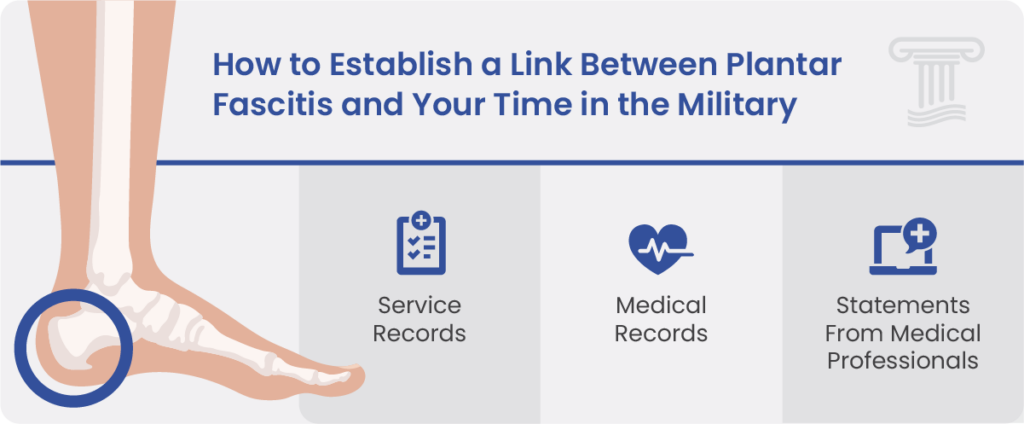VA Rating for Plantar Fasciitis: A Comprehensive Guide
Category: Veterans Disability Law
Article by Daniel J. Tuley

Plantar fasciitis is a common foot condition that affects many people, particularly those who have served in the military. Veterans often experience health issues related to their time in service, and plantar fasciitis pain can significantly affect their daily lives. In fact, a recent study identified high rates of plantar fasciitis in Army and Marines service members, particularly for black and female veterans.
Fortunately, the Department of Veterans Affairs (VA) recognizes the impact of these conditions and benefits eligible veterans. This blog explores the intricacies of VA ratings for plantar fasciitis, including eligibility criteria, related injuries, and the types of benefits available.
What Is Plantar Fasciitis?
Plantar fasciitis, also known as runner’s heel, is an inflammation of the connective tissue (plantar fascia) along the bottom of the foot. The most common symptom is acute heel pain, especially with the first steps in the morning or after long periods of sitting or standing.
Plantar fasciitis typically begins as a throbbing or stabbing pain that starts in the heel and radiates out toward the toes. The sole of the foot may be tender, particularly after long periods of walking or standing. In some cases, the pain is so severe that it hinders the ability to bear weight on the affected foot.
Inflammation of the plantar fascia is a repetitive use injury common in athletes and people whose work requires frequent running or standing on varied terrain. Like most repetitive strain injuries, plantar fasciitis gradually worsens over time.
VA Ratings and Disability Qualifications for Plantar Fasciitis
Plantar fasciitis disability was historically assessed under general musculoskeletal injuries, but the condition received its own diagnostic code in 2021. Today, the maximum VA rating for plantar fasciitis disability is 40 percent, with varying percentages assigned depending on the severity of the veteran’s symptoms.
- 10 percent disability applies to veterans diagnosed with plantar fasciitis in one or both feet who can function with prescribed medical treatment.
- 20 percent disability applies to veterans diagnosed with plantar fasciitis in one foot whose daily life activities are impacted despite non-surgical or surgical medical treatment.
- 30 percent disability applies to veterans diagnosed with plantar fasciitis in both feet. VA compensation is available for veterans with bilateral plantar fasciitis. This applies when their daily life activities are impacted despite non-surgical or surgical medical treatment.
- 40 percent disability applies to veterans diagnosed with plantar fasciitis who have lost the use of the affected foot.
VA also allows a particular disability rating for veterans who qualify for plantar fasciitis surgery but cannot undergo the procedure. In these cases, a rating of either 20 or 30 percent is awarded, depending on whether the condition affects one or both feet.

Conditions Related to Plantar Fasciitis
Some health problems may co-occur or result from the foot condition, and veterans may be eligible for additional compensation for these related issues. VA secondary conditions to plantar fasciitis could include:
- Knee, hip, or back pain: Eligible for compensation if changes in walking due to plantar fasciitis lead to discomfort in these areas.
- Balance issues: If the foot condition affects a veteran’s balance, leading to falls or other issues, it may be considered compensable.
- Flat feet: Pes planus, commonly known as flat feet, is a condition where the arches of the feet collapse and the sole makes contact with the ground. Individuals may qualify for a pes planus VA rating from 0 to 50 percent based on the severity of the condition and whether the foot is rigid or flexible. Veterans whose condition affects both feet are likely to qualify for a higher flat feet VA rating.
- Bunions: Hallux valgus is a deformity of the first joint of the big toe, commonly known as a bunion. Inflammation in the foot can contribute to bunions, increasing the percentage of disability.
How Can You Get Disability for Plantar Fasciitis?
Veterans must meet specific criteria to qualify for VA benefits for plantar fasciitis. Generally, veterans with service-connected disabilities are eligible for compensation and healthcare benefits. For plantar fasciitis to be considered service-connected, veterans must establish a link between their foot condition and their time in the military.
Veterans can establish a service connection by providing evidence such as:
- Service records: It’s crucial to demonstrate that plantar fasciitis originated during military service or was aggravated by it. Proof of in-service events, foot injuries, or activities that worsen plantar fasciitis (like marching and carrying heavy loads) helps establish the service connection.
- Medical records: Veterans must show a current diagnosis of plantar fasciitis and its impact on their daily activities. To strengthen the claim, veterans should provide all relevant medical records. These records should include documentation of the plantar fasciitis diagnosis, treatment history, and any military medical records related to foot pain.
- Statements from medical professionals: Veterans may need opinions from their primary care physicians, podiatrists, or surgeons to show the extent of their disability. A doctor’s opinion of how military service affects plantar fasciitis could help veterans get benefits years after leaving service.
Plantar Fasciitis and Combined Disability Rating
If you already receive benefits and have been diagnosed with plantar fasciitis, you could qualify for a VA disability increase. You could even collect compensation at the 100% disability rate if you have multiple disabling conditions that prevent you from working.
Total Disability Individual Unemployability (TDIU) benefits are available to veterans whose service-connected disabilities are a barrier to substantially gainful employment. A veteran may qualify for TDIU even if their individual disabilities do not meet the VA’s criteria for a 100% disability rating.
To be eligible for TDIU, a veteran typically needs a combination of disabilities that add up to a 60% or higher rating. If a veteran is granted TDIU, they will be compensated at the 100% disability rate even if their combined disability rating is lower than 100%. The key consideration is that the combination of service-connected disabilities renders the veteran unable to work.
Let Us Help You Get the VA Benefits You Deserve
Plantar fasciitis can be a severely disabling condition that makes it difficult to do the things you love. If you suffered one or more injuries as a result of military service, you should not have to bear those painful burdens alone.
Fill out our contact form to reach out to a Tuley Law Office VA disability lawyer and see how much compensation you may be able to receive.
Have questions about your case?
Contact us